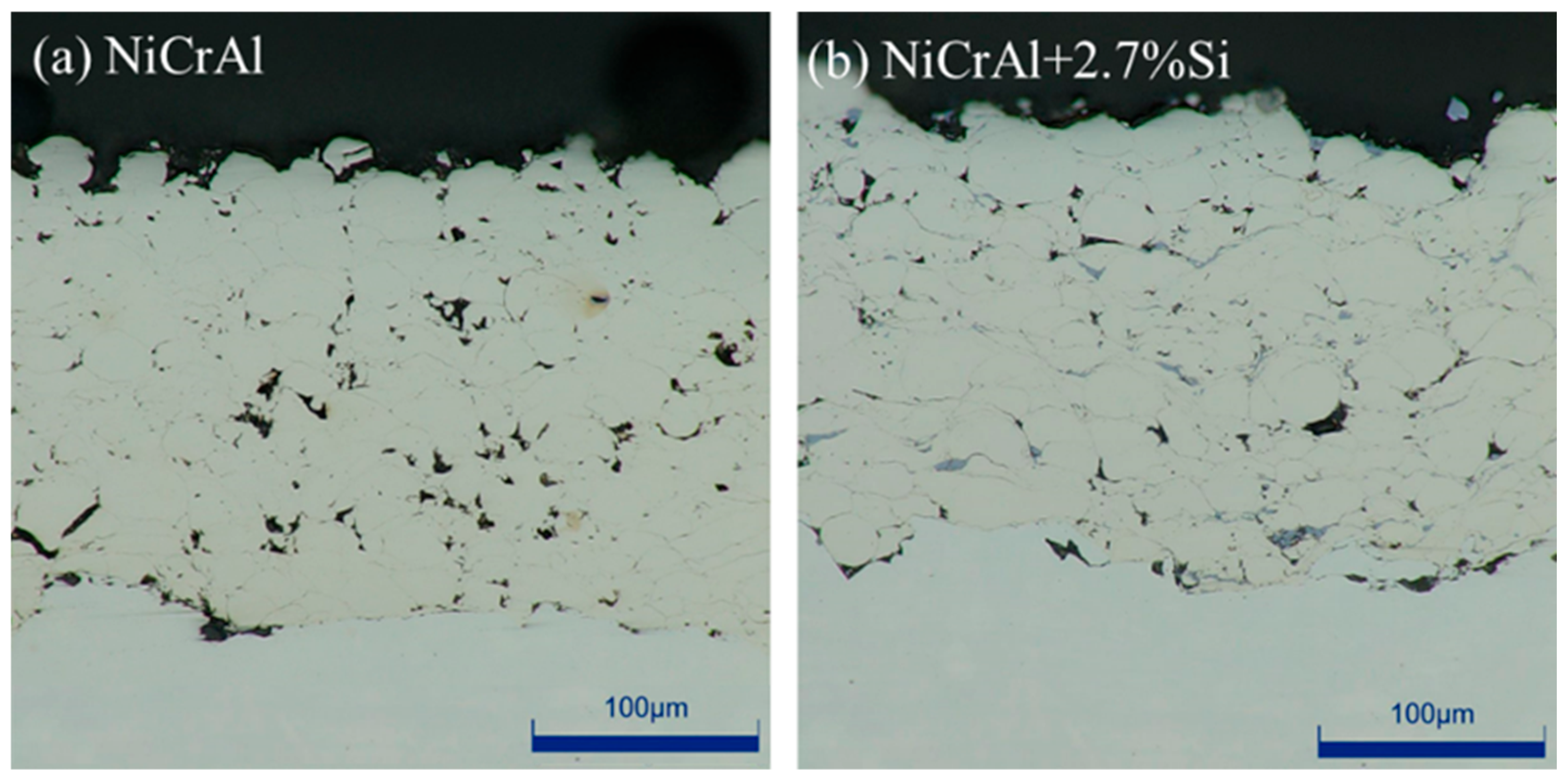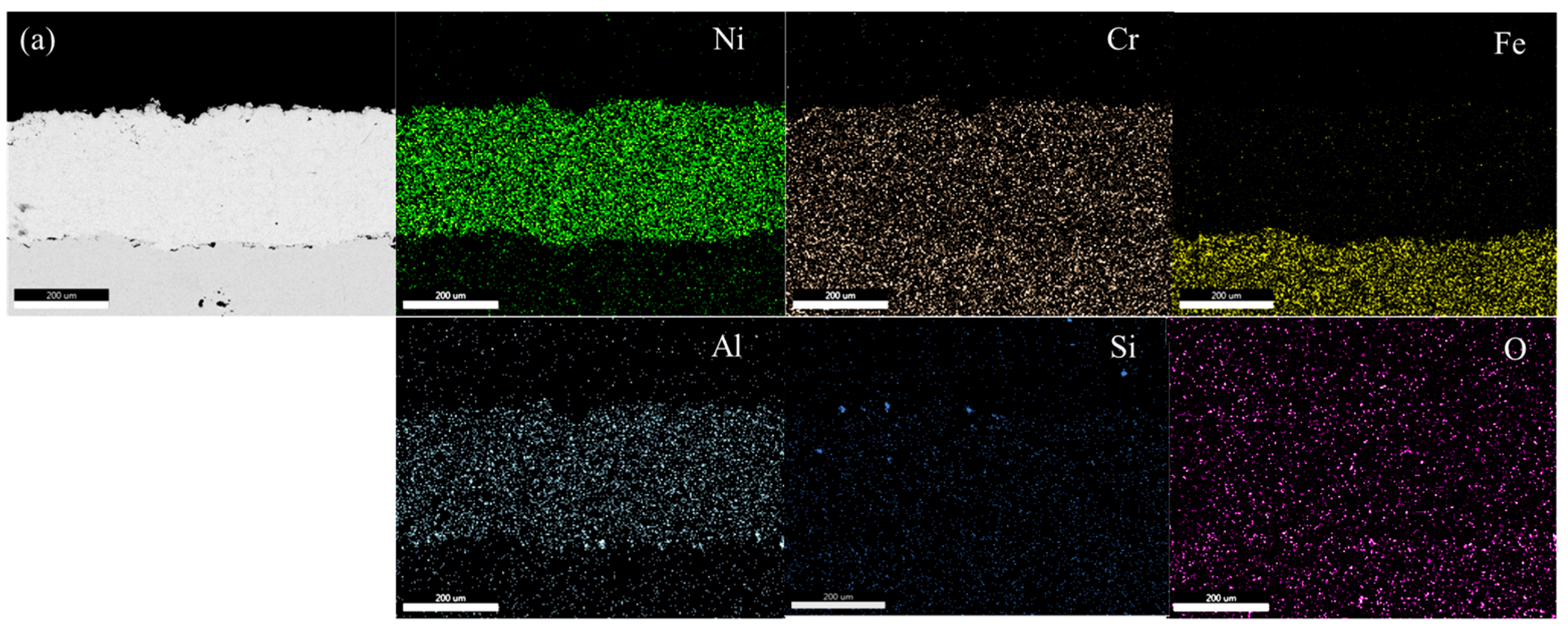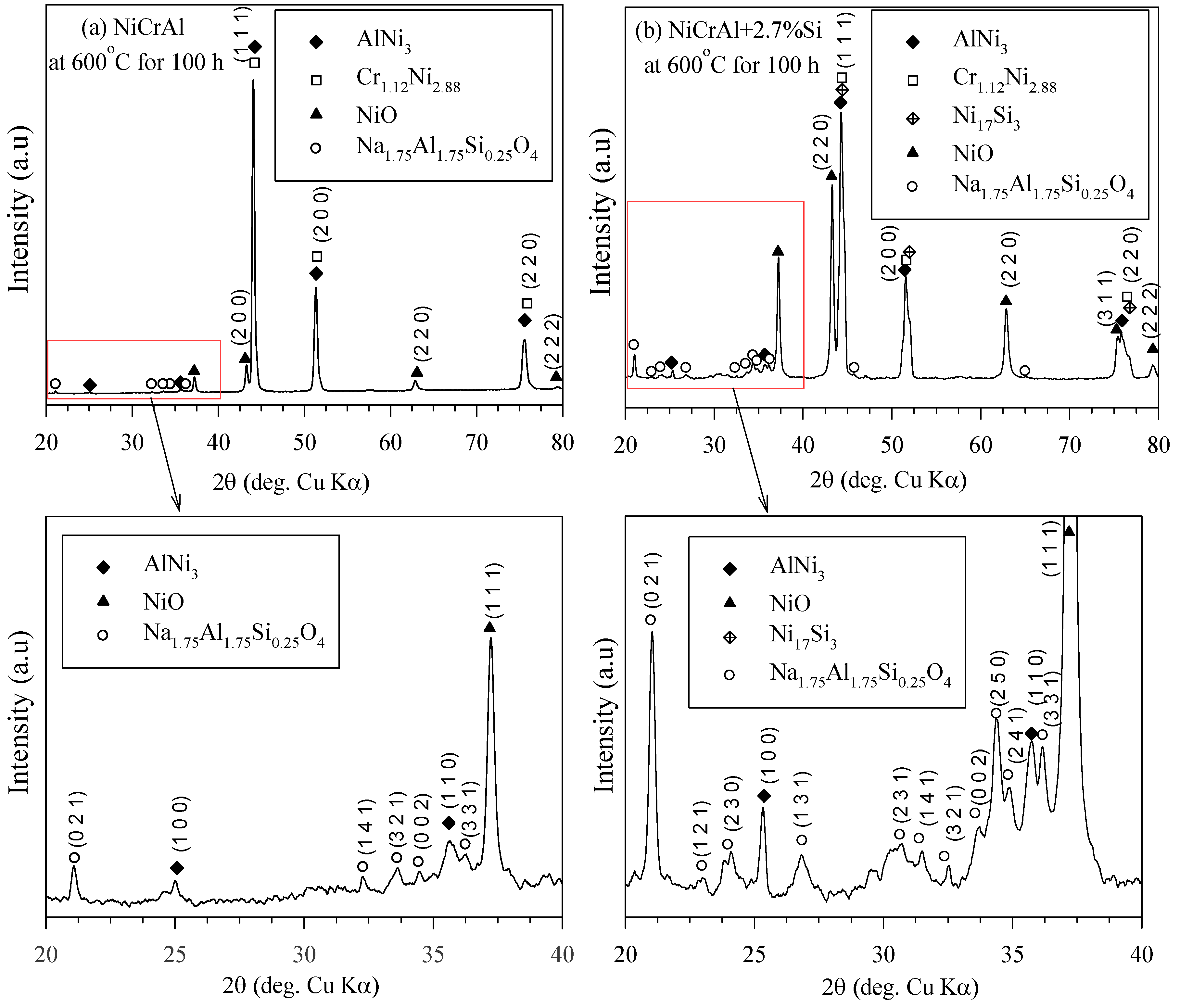Effect of Si Addition in NiCrAl Coating on Corrosion in Molten Nitrate Salt
Abstract
:1. Introduction
2. Materials and Methods
3. Results and Discussion
3.1. Before Immersion Testing
3.2. Corrosion Test
3.3. Microstructure and Chemical Composition
4. Conclusions
- When the NiCrAl coatings are exposed to modified molten nitrate salt, the mass gain and loss are more drastic at 400 °C than at 500 and 600 °C. The mass gain is due to oxidation reactions and the infiltration of molten salt, which leads to additional corrosion reactions. After prolonged exposure, oxidation products are formed and mass loss or corrosion reactions become more evident. The apparent mass gain and loss rates decline at elevated exposure temperatures. Corrosion rates depend on oxide formation and the stability of oxides forming on coating surfaces.
- The stable oxides of the coatings can be detected when exposed to modified molten salt at 600 °C. The oxidation products were NiO and sodium–aluminum–silicate, differentiated from Cr2O3, Al2O3, and Ni(Al,Cr)2O4 spinel, which formed at high-temperature exposure in air. In molten salt, Cr2O3 was volatile and dissolved in the form of chromate alkaline oxides, CrO22− and CrO42−.
- Silicon addition to the NiCrAl coating promoted the formation of Al2O3 and subsequently enhanced the formation of Na1.75Al1.75Si0.25O4, a more effective corrosion-resistant oxide. This oxide acts as a corrosion inhibitor by reducing molten salt infiltration and outward diffusion, which were the causes of corrosion progression. This resulted in a low mass change in the Si-added NiCrAl coatings.
Author Contributions
Funding
Data Availability Statement
Acknowledgments
Conflicts of Interest
References
- Ferruzzi, G.; Delcea, C.; Barberi, A.; Di Dio, V.; Di Somma, M.; Catrini, P.; Guarino, S.; Rossi, F.; Parisi, M.L.; Sinicropi, A.; et al. Concentrating Solar Power: The State of the Art, Research Gaps and Future Perspectives. Energies 2023, 16, 8082. [Google Scholar] [CrossRef]
- Alami, A.H.; Olabi, A.G.; Mdallal, A.; Rezk, A.; Radwan, A.; Rahman, S.M.A.; Shah, S.K.; Abdelkareem, M.A. Concentrating solar power (CSP) technologies: Status and analysis. Int. J. Thermofluids 2023, 18, 100340. [Google Scholar] [CrossRef]
- Zhou, Z.; Lin, A.; Wang, L.; Qin, W.; Zhao, L.; Sun, S.; Zhong, Y.; He, L.; Chen, F. Estimation of the losses in potential concentrated solar thermal power electricity production due to air pollution in China. Sci. Total Environ. 2021, 784, 147214. [Google Scholar] [CrossRef] [PubMed]
- Di Leo, S.; Pietrapertosa, F.; Salvia, M.; Cosmi, C. Contribution of the Basilicata region to decarbonisation of the energy system: Results of a scenario analysis. Renew. Sustain. Energy Rev. 2021, 138, 110544. [Google Scholar] [CrossRef]
- Goyal, N.; Aggarwal, A.; Kumar, A. Concentrated solar power plants: A critical review of regional dynamics and operational parameters. Energy Res. Soc. Sci. 2022, 83, 102331. [Google Scholar] [CrossRef]
- Canton, H.; International Energy Agency—IEA. The Europa Directory of International Organizations 2021; Routledge: Abingdon, UK, 2021; pp. 684–686. [Google Scholar] [CrossRef]
- Mueller-Steinhagen, H.; Trieb, F. Concentrating solar power, a review of the technology. Q. R. Acad. Eng. 2004, 18, 43–50. [Google Scholar]
- Bauer, T.; Breidenbach, N.; Pfleger, N.; Laing, D.; Eck, M. Overview of molten salt storage systems and material development for solar thermal power plants. In Proceedings of the World Renewable Energy Forum 2012, Denver, CO, USA, 13–19 May 2012; pp. 1–8. [Google Scholar]
- Pacio, J.; Wetzel, T. Assessment of liquid metal technology status and research paths for their use as efficient heat transfer fluids in solar central receiver systems. Sol. Energy 2013, 93, 11–12. [Google Scholar] [CrossRef]
- Fernández, A.; Rey, A.; Lasanta, I.; Mato, S.; Brady, M.; Pérez, F. Corrosion of alumina-forming austenitic steel in molten nitrate salts by gravimetric analysis and impedance spectroscopy. Mater. Corros. 2014, 65, 267–275. [Google Scholar] [CrossRef]
- Dunn, R.I.; Hearps, P.J.; Wright, M.N. Molten-salt power towers: Newly commercial concentrating solar storage. Proc. IEEE 2011, 100, 504–515. [Google Scholar] [CrossRef]
- Li, P.; Molina, E.; Wang, K.; Xu, X.; Dehghani, G.; Kohli, A.; Teja, A.S. Thermal and transport properties of NaCl–KCl–ZnCl2 eutectic salts for new generation high-temperature heat-transfer fluids. J. Sol. Energy Eng. 2016, 138, 054501. [Google Scholar] [CrossRef]
- Chen, Y.; Sun, Z.; Zhou, J. Influence of additive NaCl on the phase-change heat transfer and storage capacity of NaNO3-KNO3 mixture. Heat Technol. 2014, 32, 1–4. [Google Scholar] [CrossRef]
- Li, P.W.; Deymier, P.; Gervasio, D.; Lucas, P.; Chan, K.M.C.L.; Hao, Q.; Momayez, M. Halide and Oxy-Halide Eutectic Systems for High Performance High Temperature Heat Transfer Fluids. SunShot Concentrating Solar Power Program Review. 2013; pp. 85–86. Available online: https://www.energy.gov/sites/prod/files/2016/08/f33/04-Li_CSP-Program-Summit-presentation.pdf (accessed on 1 January 2024).
- Peng, Q.; Ding, J.; Wei, X.; Yang, J.; Yang, X. The preparation and properties of multicomponent molten salts. Apply Energy 2010, 87, 2812–2817. [Google Scholar] [CrossRef]
- Kettrakul, P.; Siripongsakul, T.; Promdirek, P. Corrosion behavior of stainless steels in molten salts used for concentrated solar power. Suranaree J. Sci. Technol. 2022, 29, 010107. [Google Scholar]
- Goods, S.H.; Bradshaw, R.W.; Prairie, M.R.; Chavez, J.M. Corrosion of Stainless and Carbon Steels in Molten Mixtures of Industrial Nitrates; Sandia National Laboratories: Livermore, CA, USA, 1994. [Google Scholar] [CrossRef]
- Bradshaw, R.W.; Goods, S.H. Corrosion Resistance of Stainless Steels during Thermal Cycling in Alkali Nitrate Molten Salts; Sandia National Laboratories: Livermore, CA, USA, 2001. [Google Scholar] [CrossRef]
- Kruizenga, A.; Gill, D. Corrosion of iron stainless steels in molten nitrate salt. Energy Procedia 2014, 49, 878–887. [Google Scholar] [CrossRef]
- Shreir, L.L.; Jarman, R.A.; Burstein, G.T. Corrosion Metal/Environment Reactions, 3rd ed.; Heinemann Ltd.: London, UK, 1994. [Google Scholar]
- Kofstad, P. High Temperature Corrosion; Elsevier: Exeter, UK, 1988. [Google Scholar]
- Ahmed, O.; Zhou, L.; Mohajeri, N.; Sohn, Y. Corrosion behaviour of AISI 304 stainless steel with solar salt heat transfer fluid. Adv. Mater. Res. 2014, 922, 13–17. [Google Scholar] [CrossRef]
- Kanjanaprayut, N.; Siripongsakul, T.; Promdirek, P. Intergranular Corrosion Analysis of Austenitic Stainless Steels in Molten Nitrate Salt Using Electrochemical Characterization. Metals 2024, 14, 106. [Google Scholar] [CrossRef]
- Ramandhany, S.; Sugiarti, E.; Desiati, R.; Martides, E.; Junianto, E.; Prawara, B.; Sukarto, A. The effect of silicon as a reactive element for NiCrAl coating performance on hastelloy substrate. In IOP Conference Series: Materials Science and Engineering, Proceedings of the 1st Materials Research Society Indonesia Conference and Congress, Yogyakarta, Indonesia, 8–12 October 2018; IOP Publishing: Bristol, UK, 2018. [Google Scholar]
- Gurrappa, I. Identification of hot corrosion resistant MCrAlY based bond coatings for gas turbine engine applications. Surf. Coat. Technol. 2001, 139, 272–283. [Google Scholar] [CrossRef]
- Yuan, K. Oxidation and Corrosion of New MCrAlX Coatings: Modelling and Experiments. Ph.D. Thesis, Linköping University Electronic Press, Linköping, Sweden, 2014. [Google Scholar]
- Smialek, J.; Jacobson, S. Oxidation of High-Temperature Aerospace Materials. In High Temperature Materials and Mechanisms, 1st ed.; CRC Press: New York, NY, USA, 2014; pp. 95–162. [Google Scholar]
- Dai, P.; Wu, Q.; Ma, Y.; Li, S.; Gong, S. The effect of silicon on the oxidation behavior of NiAlHf coating system. Appl. Surf. Sci. 2013, 271, 311–316. [Google Scholar] [CrossRef]
- Shuting, Z.; Kaiping, D.; Xianjing, R.; Ji, S. Effect of Si on Hot Corrosion Resistance of CoCrAlY Coating. Rare Met. Mater. Eng. 2017, 46, 2807–2811. [Google Scholar] [CrossRef]
- Gulbransen, E.A.; Andrew, K.F. Oxidation Studies on the Nickel-Chromium and Nickel-Chromium-Aluminum Heater Alloys. J. Electrochem. Soc. 1959, 106, 941. [Google Scholar] [CrossRef]
- Grünling, U.W.; Bauer, R. The role of silicon in corrosion-resistance high temperature coatings. Thin Solid Films 1982, 95, 3–20. [Google Scholar] [CrossRef]
- Anzini, E.; Glaenzer, N.; Mignanelli, P.M.; Hardy, M.C.; Stone, H.J.; Pedrazzini, S. The effect of manganese and silicon additions on the corrosion resistance of a polycrystalline nickel-based superalloy. Corros. Sci. 2020, 176, 109042. [Google Scholar] [CrossRef]
- Xianwei, H.; Yue, L.; Zongxin, Y.; Bingliang, G.; Zhongning, S.; Zhaowen, W. Thermal stability of sodium nitrate–sodium nitrite melts: A Raman spectra study. Spectrosc. Lett. 2018, 51, 350–355. [Google Scholar] [CrossRef]
- Oladijo, O.; Obadele, B.; Venter, A.; Cornish, L. Investigating the effect of porosity on corrosion resistance and hardness of WC-Co coatings on metal substrates. Afr. Corros. J. 2016, 2, 37–44. [Google Scholar]
- Alves, A.; Sendão, I.; Ariza, E.; Toptan, F.; Ponthiaux, P.; Pinto, A. Corrosion behaviour of porous Ti intended for biomedical applications. J. Porous Mater. 2016, 23, 1261–1268. [Google Scholar] [CrossRef]
- Federsel, K.; Wortmann, J.; Ladenberger, M. High-temperature and corrosion behavior of nitrate nitrite molten salt mixtures regarding their application in concentrating solar power plants. Energy Procedia 2015, 69, 618–625. [Google Scholar] [CrossRef]
- Nissen, D.A.; Meeker, D.E. Nitrate/nitrite chemistry in sodium nitrate-potassium nitrate melts. Inorg. Chem. 1983, 22, 716–721. [Google Scholar] [CrossRef]
- Perez, T.; Monceau, D.; Desgranges, C. Kinetic oxidation model including the transient regime for a single crystal nickel-based superalloy over the temperature range 750–1300 °C. Corros. Sci. 2022, 206, 110485. [Google Scholar] [CrossRef]
- Spiegel, M. Influence of gas phase composition on the Hot Corrosion of steels and nickel-based alloys beneath a (Ca-Na-K)-sulfate mixture containing PbSO4 and ZnSO4. Mater. Corros. 2000, 51, 303–312. [Google Scholar] [CrossRef]
- Stott, F.H.; Wood, G.H. The mechanism of oxidation of Ni-Cr-Al alloys at 1000°–1200 °C. Corros. Sci. 1971, 11, 799–812. [Google Scholar] [CrossRef]
- Young, D.J.; Chyrkin, A.; He, J.; Grüner, D.; Quadakkers, W.J. Slow transition from protective to breakaway oxidation of Haynes 214 foil at high temperature. Oxid. Met. 2013, 79, 405–427. [Google Scholar] [CrossRef]
- Xiao, H.; Cheng, Q.; Shi, H.; Li, J.; Ru, Y. The enhanced SO3 formation by alkali-metal sulfates from ash in the post-flame region during the combustion of high-alkali coal. Environ. Sci. Pollut. Res. 2020, 27, 9771–9779. [Google Scholar] [CrossRef] [PubMed]
- Kubaschewski, O.; Alcock, C.B.; Spencer, P.J. Materials Thermochemistry, 6th ed.; Great Britain: Pergamon, Turkey, 1993. [Google Scholar]







| %wt Stainless Steel | C | Mn | P | S | Si | Cr | Ni |
|---|---|---|---|---|---|---|---|
| AISI 304 (sample) | 0.05 | 1.16 | 0.02 | 0.03 | 0.45 | 18.44 | 8.05 |
| AISI 304 (standard) | <0.08 | <2.00 | <0.04 | <0.03 | <0.75 | 18.00–20.00 | 8.00–12.00 |
| Coating Powder | Composition (wt.%) | |||
|---|---|---|---|---|
| Ni | Cr | Al | Si | |
| NiCrAl | Bal. | 16 | 4.5 | <0.5 |
| NiCrAl + 2.7% Si | Bal. | 16 | 4.5 | 2.7 |
| Equipment Conditions | Parameters |
|---|---|
| Feed Rate | 30 g/min |
| O2 Pressure | 6 bar |
| Fuel Pressure | 4.5 bar |
| N2 Pressure | 6 bar |
| Air Pressure | 5 bar |
| Temperature (°C) | Conditions | k1 (mg cm−2h−1/2) | k2 (mg cm−2h−1) | R2 | at 10 h (mg cm−2h−1) | at 100 h (mg cm−2h−1) |
|---|---|---|---|---|---|---|
| 400 °C | Without Si | 3.44 × 10−3 | 3.07 × 10−4 | 0.976 | 2.37 × 10−4 | −1.40 × 10−4 |
| With 2.7% Si | 1.34 × 10−3 | 1.07 × 10−4 | 0.973 | 1.05 × 10−4 | −4.0 × 10−5 | |
| 500 °C | Without Si | 2.37 × 10−3 | 1.85 × 10−4 | 0.996 | 1.90 × 10−4 | −6.7 × 10−5 |
| With 2.7% Si | 1.33 × 10−3 | 1.14 × 10−4 | 0.994 | 9.63 × 10−5 | −4.8 × 10−5 | |
| 600 °C | Without Si | 1.54 × 10−3 | 1.09 × 10−4 | 0.686 | 1.35 × 10−4 | −3.2 × 10−5 |
| With 2.7% Si | 1.02 × 10−3 | 0.79 × 10−4 | 0.982 | 8.14 × 10−5 | −2.9 × 10−5 |
| Sample Testing | Temperature/Time | Point | Element (wt%) | ||||||
|---|---|---|---|---|---|---|---|---|---|
| O | Na | Al | Cr | Ni | Fe | Si | |||
| NiCrAl | 400 °C 25 h | A | 1.48 | - | 4.80 | 16.98 | 73.05 | 3.70 | - |
| B | 6.80 | 0.40 | 3.60 | 15.20 | 69.80 | 3.80 | 0.30 | ||
| 600 °C 100 h | A | 1.87 | - | 4.29 | 16.57 | 73.33 | 3.94 | - | |
| B | 1.70 | - | 4.70 | 15.80 | 73.40 | 4.10 | 0.30 | ||
| C | 16.30 | 0.50 | 4.50 | 6.30 | 67.80 | 4.30 | 0.40 | ||
| D | 24.00 | 0.60 | 12.3 | 8.70 | 49.20 | 4.40 | 0.80 | ||
| NiCrAl + 2.7% Si | 400 °C 25 h | A | 1.40 | - | 4.50 | 16.50 | 72.10 | 3.80 | 1.60 |
| B | 6.30 | 1.00 | 3.50 | 13.50 | 61.30 | 3.40 | 11.0 | ||
| 600 °C 100 h | A | 1.60 | - | 4.70 | 17.20 | 71.10 | 3.80 | 1.70 | |
| B | 10.44 | - | 7.67 | 13.90 | 58.11 | 4.34 | 3.83 | ||
| C | 24.80 | 4.00 | 5.10 | - | 53.70 | 7.00 | 5.30 | ||
| D | 25.70 | 4.20 | 6.10 | - | 52.90 | 5.70 | 5.40 | ||
Disclaimer/Publisher’s Note: The statements, opinions and data contained in all publications are solely those of the individual author(s) and contributor(s) and not of MDPI and/or the editor(s). MDPI and/or the editor(s) disclaim responsibility for any injury to people or property resulting from any ideas, methods, instructions or products referred to in the content. |
© 2024 by the authors. Licensee MDPI, Basel, Switzerland. This article is an open access article distributed under the terms and conditions of the Creative Commons Attribution (CC BY) license (https://creativecommons.org/licenses/by/4.0/).
Share and Cite
Siripongsakul, T.; Kettrakul, P.; Kanjanaprayut, N.; Promdirek, P. Effect of Si Addition in NiCrAl Coating on Corrosion in Molten Nitrate Salt. Metals 2024, 14, 902. https://doi.org/10.3390/met14080902
Siripongsakul T, Kettrakul P, Kanjanaprayut N, Promdirek P. Effect of Si Addition in NiCrAl Coating on Corrosion in Molten Nitrate Salt. Metals. 2024; 14(8):902. https://doi.org/10.3390/met14080902
Chicago/Turabian StyleSiripongsakul, Thamrongsin, Patchaporn Kettrakul, Noparat Kanjanaprayut, and Piyorose Promdirek. 2024. "Effect of Si Addition in NiCrAl Coating on Corrosion in Molten Nitrate Salt" Metals 14, no. 8: 902. https://doi.org/10.3390/met14080902





